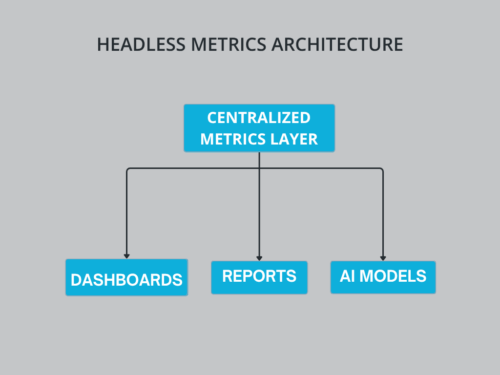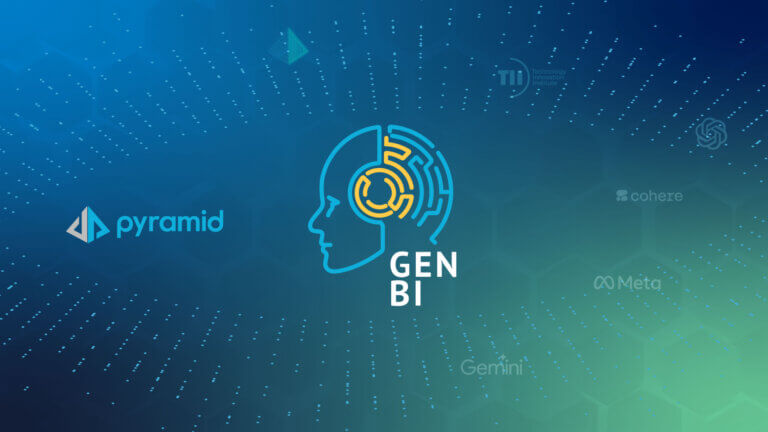Organizations today are flush with dashboards and brimming with reports. Yet they still struggle to agree on what the performance metric is actually telling us.
The root of this problem lies in the generation of redundant, inconsistent, and poorly governed metrics. In an era where analytics is supposed to drive competitive advantage, this kind of noise is more than frustrating, it’s expensive. Every duplicated formula, every dashboard tweak, and every report rework chips away at data trust and decision velocity.
As we move further into an age of AI-enhanced business, the ability to define, manage, and trust our metrics isn’t a luxury. It’s foundational.
Metrics: The backbone of trustworthy analytics
When organizations think about analytics maturity, they often focus on tools and technologies: dashboards, generative AI, machine learning (ML), and so on. But, without consistent, shared definitions of key metrics, even the best tools become glorified calculators.
A centralized approach to metrics isn’t just a matter of efficiency. It also creates a common language across business units, one that informs every visualization, model, and narrative.
Inconsistent metrics impact strategic alignment. If finance, marketing, and operations each define customer lifetime value differently, what hope is there for unified decision-making?
Governance meets agility
The traditional concern around centralized models is that they slow things down. But in the modern enterprise, this doesn’t have to be the case. Centralized doesn’t mean bureaucratic, it means governed, reusable, and trusted.
When metrics are built and stored as independent, first-class objects, decoupled from individual dashboards or reports, they become scalable building blocks. In other words, you define once, reuse everywhere. This dramatically cuts down duplication and ensures that every insight points to the same truth, as demonstrated by Pyramid’s approach to metrics layering and KPI anatomy.
One metric, infinite uses, zero guesswork
Think of your most critical business metric, whether it’s sales growth, time to market, customer retention, or another key performance indicator (KPI). Now, imagine it feeding dashboards, driving email alerts, guiding AI models, and powering natural language queries (NLQs), all from a single source of truth. No guessing, no outdated data, no multiple contradicting Excel files. That’s the promise of centralized metrics.
The best part is it also sets the stage for truly democratized analytics. Business users no longer need to guess or reverse-engineer logic. They can discover, explore, and apply metrics confidently, knowing they align with enterprise standards. Centralizing data across an organization is a foundational step toward smarter, AI-driven decisions.
Headless and flexible: The design philosophy behind centralized metrics
In traditional analytics stacks, metrics are often tied to the semantic layer or embedded directly within individual dashboards and reports. This coupling creates rigid dependencies, making metrics difficult to reuse, audit, or update consistently across an organization.
A headless metric architecture breaks this mold by decoupling metric definitions from any one interface or visualization layer. Instead, it stores and manages metrics as independent, modular assets in a central repository. These headless metrics enable various tools and personas—whether it’s BI dashboards, AI models, or external applications—to tap into the same consistent definitions.

The result is a flexible, future-ready architecture where metrics are no longer confined to where they were created. Teams gain agility without sacrificing governance, ensuring every decision-maker interacts with the same trusted logic, regardless of how or where they access the data.
The role of metrics in data storytelling
Modern analytics isn’t just about answering questions. It’s about communicating answers.
With natural language queries and storytelling features becoming table stakes, having a centralized metric layer ensures these narratives are consistent and grounded. Whether it’s a boardroom-ready storyboard or a chatbot response, the underlying logic stays the same.
This level of consistency turns data storytelling from a nice-to-have into a strategic asset. Executives don’t just see data, they derive meaning, backed by repeatable logic. According to experts at Harvard Business School, these types of well-constructed narratives increase data adoption and clarity, driving action throughout the organization.
AI and the metrics multiplier
As AI and automation become more embedded in the analytics lifecycle, the importance of centralized metrics multiplies.
Why? Because AI is only as smart as the data logic it’s built on. If your AI model is trained on conflicting definitions of “churn rate,” your predictions will be erratic, if not outright wrong.
When metrics are standardized and discoverable, AI can operate with clarity. Generative AI tools can suggest, explain, and generate content around metrics that are already defined and trusted. Instead of simply calculating metrics, your platform can explain them, generate narratives, and even detect anomalies, aligning with best practices for data centralization in AI-driven environments.
Governance without bottlenecks
A common myth is that governance slows down innovation. In reality, the right kind of governance actually accelerates it.
When centralized metrics are integrated into a governed platform, business teams can operate with freedom inside defined guardrails. They get the tools to explore and build, but with confidence that they’re working with sanctioned, certified logic.
This is especially critical in regulated industries, where auditability, traceability, and consistency aren’t just best practices, they’re legal requirements.
Composable analytics starts with consistent logic
Enterprises today want composability: the to tailor analytics experiences by embedding them into custom applications, workflows, or user interfaces. But, without a shared metric foundation, composability turns into chaos.
A headless, centralized metric layer ensures consistent logic across embedded contexts, so insights remain aligned whether surfaced in an internal dashboard, executive report, or customer-facing portals. This model enables flexibility without sacrificing governance, and it’s a core advantage of Pyramid’s composable analytics architecture.
By the way, Pyramid was ranked #1 in Metrics Creation in the 2025 Gartner Critical Capabilities report. That’s because Pyramid’s all-in-one analytics platform treats metrics not as an afterthought, but as a core capability: headless, governed, and powered by AI.
Building the cognitive layer of analytics
Think of centralized metrics as the first step toward a cognitive analytics environment, one where AI, users, and systems operate with shared understanding.
This isn’t just about accuracy. It’s about speed, trust, and strategic alignment. From generating insights to automating decisions, everything becomes smoother when your metrics are consistent, governed, and intelligently designed.
Start with metrics, not dashboards
Too many analytics strategies start with visualizations. But visuals without logic are just decoration.
If you want an analytics stack that scales, adapts, and actually drives business impact, start with metrics.
In an era where speed and trust are non-negotiable, centralized metrics aren’t just a better approach. They’re the only one that scales.
Curious how Pyramid makes it happen? Check out the 2025 Gartner Critical Capabilities report.













